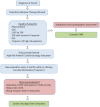Diagnostic Strategies for Early Recognition of Cancer Therapeutics-Related Cardiac Dysfunction
- PMID: 28469492
- PMCID: PMC5392033
- DOI: 10.1177/1179546817697983
Diagnostic Strategies for Early Recognition of Cancer Therapeutics-Related Cardiac Dysfunction
Abstract
Cardiovascular toxicity in the form of cardiac dysfunction continues to be an obstacle for patients with cancer. Survival and quality of life of cancer survivors are frequently affected by increased incidence of cardiovascular disease. The involvement of the cardiovascular system by primary or secondary malignancies, as well as its dysfunction secondary to the administration of antineoplastics, has led to the development of a new discipline called Cardio-Oncology, an exciting cardiology subspecialty with more questions than answers and as a result an enormous opportunity for research in the field. Multidisciplinary efforts have been focused on the prevention, diagnosis, and treatment of cancer therapeutics-related cardiovascular dysfunction (CTRCD). This review article will focus on the early diagnosis of left ventricular dysfunction associated with chemotherapy. Currently, the identification of cardiac toxicity associated with cancer treatment is the cornerstone for critical decisions regarding anticancer therapy and cardioprotective strategies. Its early detection, especially in subclinical phases, allows immediate intervention to prevent further impairment of the myocardium and other cardiovascular structures. The most significant published studies were selected for this revision, providing an updated document for the health professionals involved in the care of patients with cancer. We examined the current evidence and recommendations for biochemical and noninvasive diagnostic techniques, including their specific role for identification of CTRCD. Traditional and advanced imaging modalities, used alone or in combination with cardiovascular biomarkers, are essential for the recognition of cardiotoxicity during cancer therapy. Evolving basic and clinical research are focused on the development of more sensitive and specific diagnostic tools and for the recognition of cardiac toxicity.
Keywords: Cardiomyopathy; cardiotoxicity; chemotherapy.
Conflict of interest statement
DECLARATION OF CONFLICTING INTERESTS: The author(s) declared no potential conflicts of interest with respect to the research, authorship, and/or publication of this article.
Figures







Similar articles
-
Rationale and design of the multidisciplinary team IntervenTion in cArdio-oNcology study (TITAN).BMC Cancer. 2016 Sep 15;16(1):733. doi: 10.1186/s12885-016-2761-8. BMC Cancer. 2016. PMID: 27629548 Free PMC article.
-
Diagnosis and Management of Cancer Treatment-Related Cardiac Dysfunction and Heart Failure in Children.Children (Basel). 2023 Jan 12;10(1):149. doi: 10.3390/children10010149. Children (Basel). 2023. PMID: 36670699 Free PMC article. Review.
-
The Australia and New Zealand Cardio-Oncology Registry: evaluation of chemotherapy-related cardiotoxicity in a national cohort of paediatric cancer patients.Intern Med J. 2021 Feb;51(2):229-234. doi: 10.1111/imj.14719. Intern Med J. 2021. PMID: 31841257
-
Advances in Biomarkers for Detecting Early Cancer Treatment-Related Cardiac Dysfunction.Front Cardiovasc Med. 2021 Nov 10;8:753313. doi: 10.3389/fcvm.2021.753313. eCollection 2021. Front Cardiovasc Med. 2021. PMID: 34859069 Free PMC article. Review.
-
An Overview of Cardio-Oncology, a New Frontier to Be Explored.Acta Cardiol Sin. 2021 Sep;37(5):457-463. doi: 10.6515/ACS.202109_37(5).20210706A. Acta Cardiol Sin. 2021. PMID: 34584378 Free PMC article. Review.
Cited by
-
Anthracycline-induced cardiotoxicity in the chemotherapy treatment of breast cancer: Preventive strategies and treatment.Mol Clin Oncol. 2019 Jul;11(1):15-23. doi: 10.3892/mco.2019.1854. Epub 2019 May 8. Mol Clin Oncol. 2019. PMID: 31289672 Free PMC article. Review.
-
Cardiotoxicity of Anticancer Therapeutics.Front Cardiovasc Med. 2018 Feb 7;5:9. doi: 10.3389/fcvm.2018.00009. eCollection 2018. Front Cardiovasc Med. 2018. PMID: 29473044 Free PMC article. Review.
-
An update of the molecular mechanisms underlying anthracycline induced cardiotoxicity.Front Pharmacol. 2024 Jun 26;15:1406247. doi: 10.3389/fphar.2024.1406247. eCollection 2024. Front Pharmacol. 2024. PMID: 38989148 Free PMC article. Review.
-
Prognostic Factors for Cardiotoxicity among Children with Cancer: Definition, Causes, and Diagnosis with Omics Technologies.Diagnostics (Basel). 2023 May 26;13(11):1864. doi: 10.3390/diagnostics13111864. Diagnostics (Basel). 2023. PMID: 37296716 Free PMC article. Review.
-
Computational Analysis of Cardiac Contractile Function.Curr Cardiol Rep. 2022 Dec;24(12):1983-1994. doi: 10.1007/s11886-022-01814-1. Epub 2022 Oct 27. Curr Cardiol Rep. 2022. PMID: 36301405 Free PMC article. Review.
References
-
- Miller KD, Siegel RL, Lin CC, et al. Cancer treatment and survivorship statistics, 2016. CA Cancer J Clin. 2016;66:271–289. - PubMed
-
- Seidman A, Hudis C, Pierri MK, et al. Cardiac dysfunction in the trastuzumab clinical trials experience. J Clin Oncol. 2002;20:1215–1221. - PubMed
-
- Yeh ET, Bickford CL. Cardiovascular complications of cancer therapy: incidence, pathogenesis, diagnosis, and management. J Am Coll Cardiol. 2009;53:2231–2247. - PubMed
-
- Friedman MA, Bozdech MJ, Billingham ME, Rider AK. Doxorubicin cardiotoxicity. Serial endomyocardial biopsies and systolic time intervals. JAMA. 1978;240:1603–1606. - PubMed
-
- Minotti G, Menna P, Salvatorelli E, Cairo G, Gianni L. Anthracyclines: molecular advances and pharmacologic developments in antitumor activity and cardiotoxicity. Pharmacol Rev. 2004;56:185–229. - PubMed
Publication types
LinkOut - more resources
Full Text Sources
Other Literature Sources

